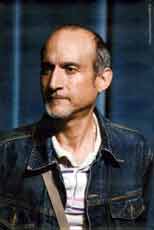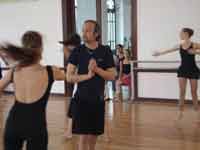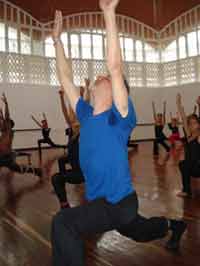TOPIC OF THE WEEK
The Cuban
National Ballet School and
National Dance Academy of Rome:
a one year fruitful exchange
 An
interview with the Father of Italian Contemporary
Dance, Professor Joseph Fontano about their
bilateral cooperation.
An
interview with the Father of Italian Contemporary
Dance, Professor Joseph Fontano about their
bilateral cooperation.
by Damián Donéstevez.
-Different actions have been
taken this year as part of an ongoing exchange
between the National Dance Academy of Rome, which
you represent, and the Cuban National Ballet School.
Can you elaborate?
The
National Dance Academy, based in Rome, is the only
government institute for dance in Italy and today it
is the only institute that has a degree programme in
dance for teaching, dancing and choreographing.
Last
year after having been invited to Cuba, to the
Escuela Nacional de Ballet, I came back home to Rome
thinking that our dance academy would grow a great
deal if we could start a cultural exchange with the
national ballet school. As a member of the Academic
Council I presented them with a programme for
exchange. The Directress Ramona De Saa was very
enthusiastic to start and exchange with our academy.
The
first part of the exchange was that I would have
returned to Cuba to teach and give lectures again
and that 5 students and one teacher from our academy
could come with me. The first part of the exchange
was wonderful; the students received excellent dance
notions and had the pleasure and honour of seeing
Alicia Alonso and to have taken dance classes with
the father of the Cuban National Ballet School,
Professor Fernando Alonso. I taught contemporary
dance classes and held a series of lectures within
the International Ballet Academies Encounter that
took place within the National Ballet School of
Cuba.
 -
Your Academy recently received the visit of National
Ballet School principal Dr. Ramona de Saa Bello,
better known as Chery, who exchanged experiences
with your teachers and students. How were her
classes, what age groups did she teach, what were
the basic principles of her class?
-
Your Academy recently received the visit of National
Ballet School principal Dr. Ramona de Saa Bello,
better known as Chery, who exchanged experiences
with your teachers and students. How were her
classes, what age groups did she teach, what were
the basic principles of her class?
The
second part of our exchange was to have Directress
Ramona De Saa come to Italy and teach the Cuban
dance method to our professors and students. The
academy in Rome is of University level and they had
the pleasure to have had classes in both technique
and methodology.
Everyone was amazed by the amount of knowledge that
Ramona De Saa has in teaching and in creating and
educating a body to dance. The teachers wanted her
to stay on and hope that she will come back for a
longer visit the next time. The students hope soon
that they will be able once again to have dance
classes with her. Her classes were simple and to the
point, artistic and, at the same time, very
educational.
- There is still an important part of the exchange
to be fulfilled, including the participation of
Cuban ballet students in an international ballet
competition in Rome. Can you elaborate?
The
third part of the exchange is to have Cuban dance
students from the Escuela Nacional de Ballet of Cuba
to come to the National Dance Academy of Italy and
to be candidates for the dance competition Premio
Roma. Four students and one professor from Cuba have
been invited to come to Rome. They include Estheysi
Menéndez, Aniela Perorín, Luis David Valle,
Jonathan, a French boy who was on a one year
scholarship at the Cuban National Ballet School and
is now dancing with the Royal Danish Ballet, and
professor Mirtha Hermida Roque.
The
dance competition each year sees many dancers from
various countries around the world. One of the
important aspects of this contest is that it is
broadcast on national television.
 -
What are the antecedents of this bilateral
cooperation between the National Dance Academy of
Rome and the Cuban National Ballet School?
-
What are the antecedents of this bilateral
cooperation between the National Dance Academy of
Rome and the Cuban National Ballet School?
Basically I felt that the Italian dance world could
gain much knowledge from the interesting dance
experiences that Cuba has accumulated in the past 60
years. I was overwhelmed on my first trip to Cuba,
and reconfirmed, on my second visit, that the Cuban
dance world has much to teach to European dancers
and teachers, in particular for classical ballet, in
exchange I hope to be able to enrich Cuba with a
touch of European contemporary dance.
- I understand that you will
choreograph a contemporary piece for the students
next year as part of the International Ballet
Academies Encounter scheduled to take place in
Havana in Easter, am I right? Have you thought of
any ideas for it?
Yes,
it is true. I have been invited to choreograph next
year for the Escuela Nacional de Ballet. I am very
excited to work with such talented students. The
first thing that I can think about at this moment is
to leave them with a part of me and of my artistic
approach to dance; the rest is just “show business”.
- Do you think this exchange
will continue in the future? What actions do you
think the two sides should take to continue this
experience?
It
is important that the exchange goes on and that it
grows. It would be wonderful to have more of our
European teachers come and see the Cuban methodology
and that many dancers should visit and study at the
school in Cuba. On the other hand, it would be
interesting for a few contemporary dance teachers,
choreographers and students to come to our academy
in Rome to gain the notions of this new art dance
form.
- Anything else you would
like to add?
I
want to thank all of the people who work behind the
wings and who make cultural exchanges like mine
possible and who put them into act…and yes with this
year being the 60th anniversary of the founding of
the Cuban National Ballet Company, I would like to
wish everyone to have wonderful celebrations and to
remember that the world knows that Cuba is there and
that it works in hard and honest way to stay alive.
I admire the way that you all are able to create and
go forward; it is a fantastic lesson for the entire
globe.